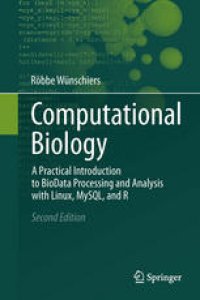
Ebook: Computational Biology: A Practical Introduction to BioData Processing and Analysis with Linux, MySQL, and R
Author: Röbbe Wünschiers (auth.)
- Genre: Computers // Databases
- Tags: Computer Appl. in Life Sciences, Bioinformatics, Proteomics, Biochemistry general, Computer Applications, Biophysics and Biological Physics
- Year: 2013
- Publisher: Springer-Verlag Berlin Heidelberg
- Edition: 2
- Language: English
- pdf
This greatly expanded 2nd edition provides a practical introduction to
- data processing with Linux tools and the programming languages AWK and Perl
- data management with the relational database system MySQL, and
- data analysis and visualization with the statistical computing environment R
for students and practitioners in the life sciences. Although written for beginners, experienced researchers in areas involving bioinformatics and computational biology may benefit from numerous tips and tricks that help to process, filter and format large datasets. Learning by doing is the basic concept of this book. Worked examples illustrate how to employ data processing and analysis techniques, e.g. for
- finding proteins potentially causing pathogenicity in bacteria,
- supporting the significance of BLAST with homology modeling, or
- detecting candidate proteins that may be redox-regulated, on the basis of their structure.
All the software tools and datasets used are freely available. One section is devoted to explaining setup and maintenance of Linux as an operating system independent virtual machine. The author's experiences and knowledge gained from working and teaching in both academia and industry constitute the foundation for this practical approach.
This greatly expanded 2nd edition provides a practical introduction to
- data processing with Linux tools and the programming languages AWK and Perl
- data management with the relational database system MySQL, and
- data analysis and visualization with the statistical computing environment R
for students and practitioners in the life sciences. Although written for beginners, experienced researchers in areas involving bioinformatics and computational biology may benefit from numerous tips and tricks that help to process, filter and format large datasets. Learning by doing is the basic concept of this book. Worked examples illustrate how to employ data processing and analysis techniques, e.g. for
- finding proteins potentially causing pathogenicity in bacteria,
- supporting the significance of BLAST with homology modeling, or
- detecting candidate proteins that may be redox-regulated, on the basis of their structure.
All the software tools and datasets used are freely available. One section is devoted to explaining setup and maintenance of Linux as an operating system independent virtual machine. The author's experiences and knowledge gained from working and teaching in both academia and industry constitute the foundation for this practical approach.
This greatly expanded 2nd edition provides a practical introduction to
- data processing with Linux tools and the programming languages AWK and Perl
- data management with the relational database system MySQL, and
- data analysis and visualization with the statistical computing environment R
for students and practitioners in the life sciences. Although written for beginners, experienced researchers in areas involving bioinformatics and computational biology may benefit from numerous tips and tricks that help to process, filter and format large datasets. Learning by doing is the basic concept of this book. Worked examples illustrate how to employ data processing and analysis techniques, e.g. for
- finding proteins potentially causing pathogenicity in bacteria,
- supporting the significance of BLAST with homology modeling, or
- detecting candidate proteins that may be redox-regulated, on the basis of their structure.
All the software tools and datasets used are freely available. One section is devoted to explaining setup and maintenance of Linux as an operating system independent virtual machine. The author's experiences and knowledge gained from working and teaching in both academia and industry constitute the foundation for this practical approach.
Content:
Front Matter....Pages i-xxix
Front Matter....Pages 1-1
Introduction....Pages 3-9
Content of This Book....Pages 11-17
Front Matter....Pages 19-19
Unix/Linux....Pages 21-35
Front Matter....Pages 37-37
The First Touch....Pages 39-51
Working with Files....Pages 53-70
Playing with Text and Data Files....Pages 71-75
Using the Shell....Pages 77-96
Front Matter....Pages 97-114
AWK....Pages 115-123
Perl....Pages 125-155
Other Programming Languages....Pages 157-174
Front Matter....Pages 175-193
Relational Databases with MySQL....Pages 195-195
Front Matter....Pages 197-254
Genomic Analysis of the Pathogenicity Factors from E. coli Strain O157:H7 and EHEC Strain O104:H4....Pages 255-290
Limits of BLAST and Homology Modeling....Pages 291-292
Virtual Sequencing of pUC18c....Pages 293-293
Back Matter....Pages 295-315
Querying for Potential Redox-Regulated Enzymes....Pages 317-341
....Pages 343-343